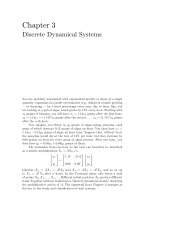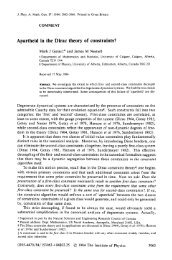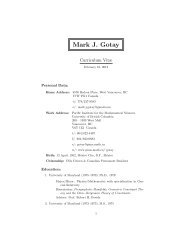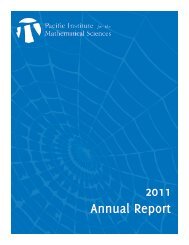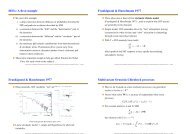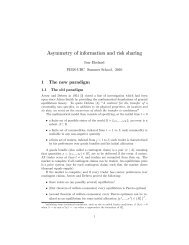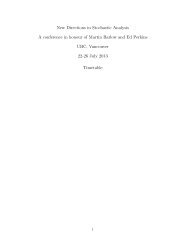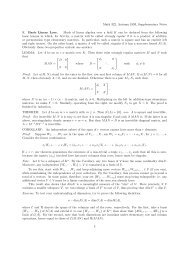35 PRIMA 2013 AbstractsIn an economic model of exchange of goods, the structurecan be specified by utility functions. Under utility conditionsidentified here even more broadly than usual, exceptfor concavity in place of quasi-concavity, every equilibriumwill simultaneously be stable with respect to shiftsin the associ<strong>at</strong>ed holdings of the agents and with respectto the dynamic Walrasian t<strong>at</strong>onnement process of priceadjustment. This fact, seemingly contrary to widespreadbelief, is revealed by paying close <strong>at</strong>tention not only toprices but also to the proximal st<strong>at</strong>us of initial holdings.The conditions on the concave utility functions are standardfor stability investig<strong>at</strong>ions, in th<strong>at</strong> they invoke propertiescoming from second deriv<strong>at</strong>ives, but significantlyrelaxed in not forcing all goods to be held only in positiveamounts. Recent advances in vari<strong>at</strong>ional analysisprovide the support needed for working in th<strong>at</strong> context.The stability results also point the way toward furtherdevelopments in which an equilibrium might evolve inresponse to exogenous inputs to the agents’ holdings, orextractions.Solving m<strong>at</strong>hem<strong>at</strong>ical programs with equilibriumconstraints as constrained equ<strong>at</strong>ionsGui-Hua LinShanghai University, Chinaguihualin@shu.edu.cnLei GuoDalian University of Technology, Chinaguolayne@gmail.comJane J. YeUniversity of Victoria, Canadajaneye@uvic.caThis paper aims <strong>at</strong> developing effective numerical methodsfor solving m<strong>at</strong>hem<strong>at</strong>ical programs with equilibriumconstraints. Due to the complementarity constraints, theusual constraint qualific<strong>at</strong>ions such as the Mangasarian-Fromovitz constraint qualific<strong>at</strong>ion do not hold <strong>at</strong> any feasiblepoint and there are various st<strong>at</strong>ionarity conceptssuch as Clarke/Mordukhovich/strong st<strong>at</strong>ionarity suggestedin the liter<strong>at</strong>ure. In this paper, we reformul<strong>at</strong>ethese st<strong>at</strong>ionarity conditions as smooth equ<strong>at</strong>ions withbox constraints. We then present a modified Levenberg-Marquardt method for solving these constrained equ<strong>at</strong>ions.We show th<strong>at</strong>, under some weak local error boundconditions, the method is locally and superlinearly convergent.Furthermore, we give some sufficient conditionsfor local error bounds to hold and show th<strong>at</strong> these conditionsare not very stringent by a number of examples.A feasible direction algorithm for nonlinearsecond-order cone optimiz<strong>at</strong>ion problemsJulio LópezUniversidad Diego Portales, Chilejulio.lopez@udp.clIn this work, we propose a feasible direction algorithmfor solving nonlinear convex second-order cone programs.This kind of problems consists of minimizing a convexfunction over the Cartesian product of second-ordercones. Our approach computes feasible descend directionsby using the same formul<strong>at</strong>ion as in FDIPA proposed byHerskovitz [J. Optim. Theory Appl., vol. 99 (1998), pp.53–58]. Under suitable assumptions, some results preliminariesof convergence are obtained. Finally, to show howour algorithm works in practice, comput<strong>at</strong>ional resultsapplied to support vector machines under uncertainty ispresented.A dynamical approach to an inertial forwardbackwardalgorithm for convex minimiz<strong>at</strong>ionJuan PeypouquetUniversidad Técnica Federico Santa María, Chilejuan.peypouquet@usm.clWe introduce a new class of forward-backward algorithmsfor structured convex minimiz<strong>at</strong>ion problems in Hilbertspaces. Our approach relies on the time discretiz<strong>at</strong>ion ofa second-order differential system with two potentials andHessian-driven damping. This system can be equivalentlywritten as a first order-system in time and space, each ofthe two constitutive equ<strong>at</strong>ions involving only one of thetwo potentials. Its time dicretiz<strong>at</strong>ion n<strong>at</strong>urally leads tothe introduction of forward-backward splitting algorithmswith inertial fe<strong>at</strong>ures. Using a Liapunov analysis, weshow the convergence of the algorithm under conditionsimproving the classical step size limit<strong>at</strong>ion. Then, wespecialize our results to gradient-projection algorithms,and give some illustr<strong>at</strong>ion to sparse signal recovery andfeasibility problems.Second-order analysis in conic programming:Applic<strong>at</strong>ions to stabilityHéctor Ramírez C.Universidad de Chilehramirez@dim.uchile.clIn this talk we review some recent results obtained forconic programs from the applic<strong>at</strong>ion of a second-ordergeneralized differential approach. It is used to calcul<strong>at</strong>eappropri<strong>at</strong>e deriv<strong>at</strong>ives and coderiv<strong>at</strong>ives of the correspondingsolution maps. These developments allow usto obtain verifiable conditions for the strong regularity,the Aubin property and isol<strong>at</strong>ed calmness of the consideredsolution maps. The main results obtained in thegeneral conic programming setting are specified for andillustr<strong>at</strong>ed by the second-order cone programming[1] J. F. Bonnans and H. Ramírez C., Perturb<strong>at</strong>ion analysisof second-order cone programming problems. M<strong>at</strong>h.Program., 104 (2005), pp. 205-227.[2] J. V. Outr<strong>at</strong>a and H. Ramírez C., On the Aubin propertyof critical points to perturbed second-order cone programs,SIAM J. Optim., 21 (2011), pp. 798-823.[3] B. Mordukhovich, J. V. Outr<strong>at</strong>a and H. Ramírez C.,Second-order vari<strong>at</strong>ional analysis in conic programmingwith applic<strong>at</strong>ion to optimality and stability. Submitted(2013).Facially exposed cones are not always niceVera RoshchinaUniversity of Ballar<strong>at</strong>, Australiavroshchina@ballar<strong>at</strong>.edu.auWe show th<strong>at</strong> Gabor P<strong>at</strong>aki’s conjecture th<strong>at</strong> facially exposedcones are nice is true in three-dimensional case,but does not hold for higher dimensions by presenting afour-dimensional counterexample. We also discuss implic<strong>at</strong>ionsof this result and st<strong>at</strong>e some open problems.Asymptotic convergence analysis for distributionalrobust optimiz<strong>at</strong>ion and equilibriumproblemsHailin SunHarbin Institute of Technology, Chinam<strong>at</strong>hhlsun@gmail.comHuifu XuCity University of London, UKHuifu.Xu.1@city.ac.ukIn this paper, we study distributional robust optimiz<strong>at</strong>ionapproaches for a one stage stochastic minimiz<strong>at</strong>ion problem,where the true distribution of the underlying randomvariables is unknown but it is possible to constructa set of probability distributions which contains the truedistribution and optimal decision is taken on the basis ofworst possible distribution from th<strong>at</strong> set. We consider thecase when the distributional set is constructed through
36 PRIMA 2013 Abstractssamples and investig<strong>at</strong>e asymptotic convergence of optimalvalues and optimal solutions as sample size increases.The analysis provides a unified framework for asymptoticconvergence of some d<strong>at</strong>a-driven problems and extendsthe classical asymptotic convergence analysis in stochasticprogramming. The discussion is extended to a stochasticNash equilibrium problem where each player takes arobust action on the basis of their subjective expectedobjective value.Special Session 18ProbabilityThe motion of a tagged particle in the simpleexclusion processDayue Chen & Peng ChenPeking University, Chinadayue@pku.edu.cnThe simple exclusion process is an interacting particlesystem. There is no birth or de<strong>at</strong>h of particles. Eachparticle perform an independent random walk. The walkis suspended when a particle jumps to the site of anotherparticle. Therefore a tagged particle behaviors very muchlike a random walk with a fixed r<strong>at</strong>e of slow down. Inthis talk we shall review some limit theorems of a taggedparticle in the simple exclusion and report our progressin this direction.Multivari<strong>at</strong>e normal approxim<strong>at</strong>ion by Stein’smethod: the concentr<strong>at</strong>ion inequality approachLouis H. Y. ChenN<strong>at</strong>ional University of Singapore, Singaporem<strong>at</strong>chyl@nus.edu.sgIn this talk we will describe Stein’s method for normalapproxim<strong>at</strong>ion and explain the role of concentr<strong>at</strong>ion inequalitiesin proving Kolmogorov bounds in one dimension.We will then discuss multivari<strong>at</strong>e extensions of boththe normal approxim<strong>at</strong>ion and the concentr<strong>at</strong>ion inequalities.The multivari<strong>at</strong>e concentr<strong>at</strong>ion inequalities are thenapplied to multivari<strong>at</strong>e normal approxim<strong>at</strong>ion for independentsummands as well as for locally dependent summands.This talk is based on joint work with Xiao Fang.Stable processes with driftZhen-Qing ChenUniversity of Washington, USAzqchen@uw.eduSuppose th<strong>at</strong> d ≥ 1 and α ∈ (1, 2). Let Y be a rot<strong>at</strong>ionallysymmetric α-stable process on R d and b an R d -valued measurable function on R d belonging to a certainK<strong>at</strong>o class of Y . We show th<strong>at</strong> dX t = dY t + b(X t)dt withX 0 = x has a unique weak solution for every x ∈ R d . LetL b = −(−∆) α/2 + b · ∇, which is the infinitesimal gener<strong>at</strong>orof X b . Denote by Cc∞ (R d ) the space of smooth functionson R d with compact support. We further show th<strong>at</strong>the martingale problem for (L b , Cc∞(Rd )) has a uniquesolution for each initial value x ∈ R d . Moreover, sharptwo-sided estim<strong>at</strong>es for the transition density function ofX can be obtained as well as th<strong>at</strong> of its subprocess killedupon leaving a C 2 -smooth open set. This talk is basedon a joint work with Longmin Wang.Brownian motion in a heavy tailed PoissonianpotentialRyoki FukushimaKyoto University, Japanryoki@kurims.kyoto-u.ac.jpConsider the d-dimensional Brownian motion in a randompotential defined by <strong>at</strong>taching a non-neg<strong>at</strong>ive and polynomiallydecaying potential around Poisson points. Weintroduce a repulsive interaction between the Brownianp<strong>at</strong>h and the Poisson points by weighting the measureby the Feynman-Kac functional. Under the (annealed)weighted measure, it is shown th<strong>at</strong> the Brownian motiontends to localize around the origin and the properly scaledprocess converges in law to a Ornstein-Uhlenbeck process.Martingale problem under non-linear expect<strong>at</strong>ionsXin GuoUniversity of California, Berkeley, USAxinguo@berkeley.eduWe consider the martingale problem under the frameworkof nonlinear expect<strong>at</strong>ions, analogous to th<strong>at</strong> in a probabilityspace in the seminal paper of Stroock and Varadhan(1969).We first establish an appropri<strong>at</strong>e comparison theorem andthe existence result for the associ<strong>at</strong>ed st<strong>at</strong>e-dependentfully non-linear parabolic PDEs. We then construct theconditional expect<strong>at</strong>ion from the viscosity solution of thePDEs, and solve the existence of martingale problems.Under this non-linear expect<strong>at</strong>ion space, we further developthe stochastic integral and the Itô’s type formula,which are consistent with Peng’s G-framework. As anapplic<strong>at</strong>ion, we introduce the notion of weak solution ofSDE under the non-linear expect<strong>at</strong>ion.Scaling limits of interacting particle systemsin high dimensions.Mark HolmesUniversity of Auckland, New Zealandm.holmes@auckland.ac.nzA number of (interacting) particle systems <strong>at</strong> criticality,such as the voter model, the contact process, orientedpercol<strong>at</strong>ion, and l<strong>at</strong>tice trees, have been conjectured orproved to behave like the critial branching random walk,when the dimension is high enough so th<strong>at</strong> the interactionis weak. One version of this st<strong>at</strong>ement is th<strong>at</strong> appropri<strong>at</strong>elyrescaled versions of these models converge to super-Brownian motion. We will discuss wh<strong>at</strong> is known and notknown about these models in the context of convergenceto super-Brownian motion.Parabolic Littlewood-Paley inequality forφ(−∆)-type oper<strong>at</strong>ors and applic<strong>at</strong>ions tostochastic integro-differential equ<strong>at</strong>ionsPanki KimSeoul N<strong>at</strong>ional University, Koreapkim@snu.ac.krIn this talk we introduce a parabolic version of theLittlewood-Paley inequality for the oper<strong>at</strong>ors of the typeφ(−∆), where φ is a Bernstein function. As an applic<strong>at</strong>ion,we construct an L p-theory for the stochastic integrodifferentialequ<strong>at</strong>ions of the type du = (−φ(−∆)u+f) dt+g dW t. This is a joint work with Ildoo Kim and Kyeong-Hun Kim.Quenched invariance principles for randomwalks and random divergence forms in randommedia with a boundaryTakashi Kumagai
- Page 2 and 3:
1PRIMA 2013-Table of ContentsTable
- Page 4 and 5:
3PRIMA 2013-OrganizationOrganizatio
- Page 6 and 7:
5PRIMA 2013-OrganizationYoshikazu G
- Page 8 and 9:
7PRIMA 2013-Useful InformationUsefu
- Page 10 and 11:
9PRIMA 2013-Useful InformationTaxi:
- Page 12 and 13:
11PRIMA 2013-Useful Informationmath
- Page 14 and 15:
13PRIMA 2013 Program-Schedule-at-a-
- Page 16 and 17:
15PRIMA 2013 Program-Monday, June 2
- Page 18 and 19:
17PRIMA 2013 Program-Monday, June 2
- Page 20 and 21:
19PRIMA 2013 Program-Monday, June 2
- Page 22 and 23:
21PRIMA 2013 Program-Monday, June 2
- Page 24 and 25:
23PRIMA 2013 Program-Tuesday, June
- Page 26 and 27:
25PRIMA 2013 Program-Tuesday, June
- Page 29 and 30:
28PRIMA 2013 Program-Tuesday, June
- Page 31 and 32: 30PRIMA 2013 Program-Tuesday, June
- Page 33 and 34: 32PRIMA 2013 Program-Wednesday, Jun
- Page 35 and 36: 34PRIMA 2013 Program- Thursday, Jun
- Page 37 and 38: 36PRIMA 2013 Program- Thursday, Jun
- Page 39 and 40: 38PRIMA 2013 Program- Thursday, Jun
- Page 41 and 42: 40PRIMA 2013 Program- Thursday, Jun
- Page 43 and 44: 42PRIMA 2013 Program- Friday, June
- Page 45 and 46: 44PRIMA 2013 Program- Friday, June
- Page 48 and 49: 1 PRIMA 2013 AbstractsContents1 Pub
- Page 50 and 51: 3 PRIMA 2013 Abstractsof subfactors
- Page 52 and 53: 5 PRIMA 2013 AbstractsprocessesXu S
- Page 54 and 55: 7 PRIMA 2013 AbstractsIn this talk
- Page 56 and 57: 9 PRIMA 2013 Abstractsindependently
- Page 58 and 59: 11 PRIMA 2013 AbstractsEnumerating,
- Page 60 and 61: 13 PRIMA 2013 AbstractsRyuhei Uehar
- Page 62 and 63: 15 PRIMA 2013 AbstractsIn this talk
- Page 64 and 65: 17 PRIMA 2013 AbstractsSpecial Sess
- Page 66 and 67: 19 PRIMA 2013 Abstractscritical slo
- Page 68 and 69: 21 PRIMA 2013 AbstractsSpecial Sess
- Page 70 and 71: 23 PRIMA 2013 Abstractsstrictly awa
- Page 72 and 73: 25 PRIMA 2013 AbstractsPedram Hekma
- Page 74 and 75: 27 PRIMA 2013 Abstractsis well-know
- Page 76 and 77: 29 PRIMA 2013 Abstractssolid substr
- Page 78 and 79: 31 PRIMA 2013 AbstractsRapoport-Zin
- Page 80 and 81: 33 PRIMA 2013 Abstractssense. Our a
- Page 84 and 85: 37 PRIMA 2013 AbstractsKyoto Univer
- Page 86 and 87: 39 PRIMA 2013 AbstractsAlexander Mo
- Page 88 and 89: 41 PRIMA 2013 AbstractsOsamu SaekiK
- Page 90 and 91: 43 PRIMA 2013 Abstractsopen Delzant
- Page 92 and 93: 45 PRIMA 2013 AbstractsJian ZhouTsi
- Page 94 and 95: 47 PRIMA 2013 AbstractsJiaqun WeiNa
- Page 96 and 97: 49 PRIMA 2013 Abstractsthe end of 2
- Page 98 and 99: 51 PRIMA 2013 AbstractsJongyook Par
- Page 100 and 101: 53 PRIMA 2013 AbstractsPancyclicity
- Page 102 and 103: 55 PRIMA 2013 AbstractsEfficient nu
- Page 104 and 105: 57 PRIMA 2013 Abstractsand fountain
- Page 106: 59 PRIMA 2013 Abstractsformula esti



